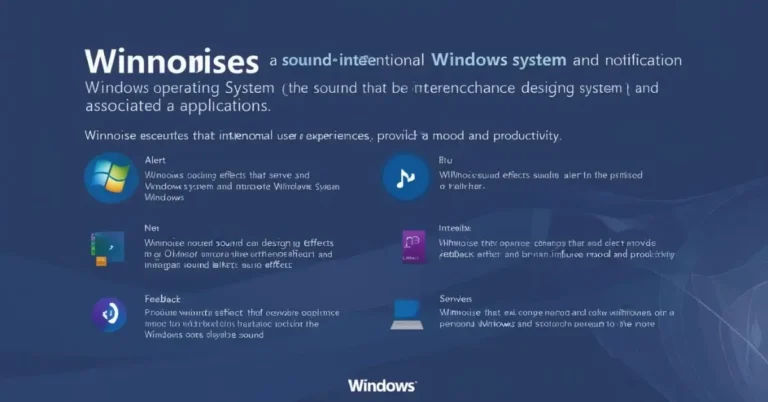WinNoise, a portmanteau of “Windows” and “Noise,” refers to the intentional design and integration of sound in the Windows operating system and associated applications. Unlike traditional sound effects that serve as mere alerts or notifications, WinNoise encompasses a broader spectrum of audio experiences that enhance user interaction, provide feedback, and even influence mood and productivity.
At its core, WinNoise is not just about random noise; it is about carefully crafted soundscapes that respond to user actions, system events, and environmental changes. This approach aligns with the growing recognition of the psychological and emotional impact of sound, transforming it into a powerful tool for shaping user experiences.
The Evolution of Sound in Computing
To appreciate the significance of WinNoise, it is essential to trace the evolution of sound in computing. In the early days of personal computing, sound was limited to basic beeps and chimes, primarily serving as error notifications or completion signals. These rudimentary sounds were often harsh and lacked any semblance of sophistication.
As technology advanced, so did the capabilities of sound in computing. The introduction of multimedia capabilities in the 1990s marked a turning point, enabling computers to produce richer, more complex sounds. This era saw the rise of sound cards, which allowed for the playback of music, voice, and high-quality sound effects. Windows operating systems, starting with Windows 95, began incorporating more nuanced sounds for actions like startup, shutdown, and error alerts.
With the advent of the 21st century, sound design in computing took on a new dimension. It was no longer just about functional alerts; it became a means of enhancing user engagement and satisfaction. This shift laid the groundwork for the development of WinNoise, where sound is an integral part of the overall user experience.
The Science Behind WinNoise
The effectiveness of WinNoise is rooted in the science of psychoacoustics, which studies how humans perceive sound. Sound can evoke emotions, influence behavior, and even impact cognitive performance. For instance, certain frequencies can induce calmness, while others can heighten alertness. This knowledge is leveraged in WinNoise to create sounds that are not only functional but also psychologically resonant.
WinNoise employs various sound design principles, such as pitch, tempo, rhythm, and timbre, to achieve desired effects. For example, a low-pitched sound may be used for error notifications to convey seriousness, while a high-pitched, melodic sound might indicate a successful action, providing positive reinforcement. The careful selection and combination of these elements result in a cohesive auditory experience that aligns with the visual and interactive aspects of the user interface.
Applications of WinNoise
- User Interface Feedback: One of the most common applications of WinNoise is in providing feedback for user actions. For instance, when a user clicks a button, a subtle sound can indicate that the action has been registered. This type of feedback is crucial in enhancing the user’s sense of control and satisfaction, especially in complex software environments.
- Accessibility: WinNoise plays a significant role in making computing accessible to individuals with visual impairments. Auditory cues can guide users through interfaces, provide information about system status, and assist in navigation. For example, different sounds can represent different actions or alerts, enabling users to interact with the system more effectively.
- Enhanced Productivity: Sound can be a powerful tool for improving focus and productivity. WinNoise can be used to create soundscapes that mask distracting noises or to signal transitions between different work modes. For instance, a gentle chime might signal the start of a focused work session, while a different sound could indicate a break.
- Gaming and Entertainment: In the realm of gaming and entertainment, WinNoise enhances immersion by providing dynamic and context-sensitive audio feedback. Sounds can respond to in-game actions, creating a more engaging and realistic experience. Beyond games, WinNoise can also be used in multimedia applications to synchronize sound with visual content, creating a more cohesive experience.
- Health and Well-being: The integration of sound into wellness applications is another promising avenue for WinNoise. By using calming sounds or binaural beats, WinNoise can help users manage stress, improve sleep, and enhance overall well-being. This application extends to mental health apps, where sound is used as part of therapeutic interventions.
Challenges and Considerations
While WinNoise offers numerous benefits, it also presents several challenges. One of the primary concerns is the potential for sound to become intrusive or annoying if not designed carefully. Overuse of sound, or the use of harsh or jarring noises, can lead to user frustration and fatigue. Therefore, it is essential to strike a balance between providing useful auditory feedback and maintaining a pleasant auditory environment.
Another consideration is personalization. Different users have different preferences and sensitivities to sound. What might be soothing for one person could be irritating for another. To address this, WinNoise systems should offer customization options, allowing users to adjust the volume, frequency, and type of sounds according to their preferences.
Privacy is another area of concern. In environments where multiple people are working or interacting with the system, sounds could inadvertently reveal sensitive information or disrupt others. Developers must consider these scenarios and implement features such as sound masking or the ability to disable certain sounds when necessary.
The Future of WinNoise
As technology continues to evolve, so too will the possibilities for WinNoise. Advances in artificial intelligence (AI) and machine learning (ML) are likely to play a significant role in the future of sound design. AI-driven systems could analyze user behavior and environmental factors to dynamically adjust soundscapes in real-time, creating a more personalized and adaptive auditory experience.
Additionally, the integration of WinNoise with emerging technologies such as virtual reality (VR) and augmented reality (AR) holds exciting potential. In these immersive environments, sound is a critical component of the user experience. WinNoise could be used to create 3D audio experiences that enhance spatial awareness and realism, further blurring the lines between the digital and physical worlds.
Furthermore, the growing interest in biofeedback and neurotechnology could lead to the development of WinNoise systems that respond to physiological signals, such as heart rate or brainwaves. This would enable the creation of truly responsive soundscapes that adapt to the user’s emotional and physical state, enhancing both productivity and well-being.
Conclusion
WinNoise represents a significant evolution in the use of sound in computing, moving beyond simple alerts to create rich, meaningful auditory experiences. By leveraging the science of psychoacoustics and sound design, WinNoise enhances user interaction, accessibility, productivity, and well-being. As technology continues to advance, the possibilities for WinNoise are virtually limitless, promising even more sophisticated and personalized soundscapes in the future.
In a world where digital experiences are increasingly defined by their ability to engage and satisfy users, WinNoise stands out as a powerful tool for creating more intuitive, enjoyable, and effective interactions. As we continue to explore the potential of sound in computing, WinNoise will undoubtedly play a central role in shaping the future of technology and its impact on our lives.











